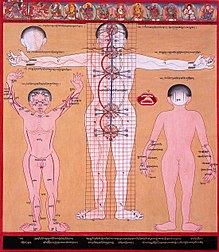
Chakras are various focal points used in a variety of ancient meditation practices, collectively denominated as Tantra, or the esoteric or inner traditions of Hinduism and Buddhism.

Tibetan Buddhism is a form of Buddhism practiced in Tibet, Bhutan and Mongolia. It also has a sizable number of adherents in the areas surrounding the Himalayas, including the Indian regions of Ladakh, Sikkim, and Arunachal Pradesh, as well as in Nepal. Smaller groups of practitioners can be found in Central Asia, Xinjiang, Inner Mongolia, and some regions of Russia, such as Tuva, Buryatia, and Kalmykia.

Tantra is an esoteric yogic tradition that developed on the Indian subcontinent from the middle of the 1st millennium CE onwards in both Hinduism and Buddhism.

Yoga is a group of physical, mental, and spiritual practices or disciplines which originated in ancient India and aim to control (yoke) and still the mind, recognizing a detached witness-consciousness untouched by the mind (Chitta) and mundane suffering (Duḥkha). There is a wide variety of schools of yoga, practices, and goals in Hinduism, Buddhism, and Jainism, and traditional and modern yoga is practiced worldwide.

Vajrayāna, also known as Mantrayāna(Mantra Vehicle),Mantranāya,Guhyamantrayāna(Secret Mantra Vehicle),Tantrayāna , Tantric Buddhism, and Esoteric Buddhism, is a Buddhist tradition of tantric practice that developed in the Indian subcontinent and spread to Tibet, Nepal, other Himalayan states, East Asia, and Mongolia.
The purpose of this timeline is to give a detailed account of Buddhism from the birth of Gautama Buddha to the present.
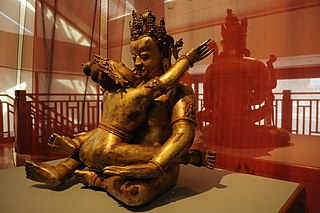
Tantric sex or sexual yoga refers to a range of practices in Hindu and Buddhist tantra that utilize sexuality in a ritual or yogic context. Tantric sex is associated with antinomian or elements such as the consumption of alcohol, and the offerings of substances like meat to deities. Moreover, sexual fluids may be viewed as power substances and used for ritual purposes, either externally or internally.

A subtle body is a "quasi material" aspect of the human body, being neither solely physical nor solely spiritual, according to various esoteric, occult, and mystical teachings. This contrasts with the mind–body dualism that has dominated Western thought. The subtle body is important in the Taoism of China and Dharmic religions such as Hinduism, Buddhism, and Jainism, mainly in the branches which focus on tantra and yoga, where it is known as the Sūkṣma-śarīra. However, while mostly associated with Asian cultures, non-dualistic approaches to the mind and body are found in many parts of the world.

Nāḍī is a term for the channels through which, in traditional Indian medicine and spiritual theory, the energies such as prana of the physical body, the subtle body and the causal body are said to flow. Within this philosophical framework, the nadis are said to connect at special points of intensity, the chakras. All nadis are said to originate from one of two centres; the heart and the kanda, the latter being an egg-shaped bulb in the pelvic area, just below the navel. The three principal nadis run from the base of the spine to the head, and are the ida on the left, the sushumna in the centre, and the pingala on the right. Ultimately the goal is to unblock these nadis to bring liberation.

Nyingma, often referred to as Ngangyur, is the oldest of the four major schools of Tibetan Buddhism. The Nyingma school is founded on the first lineages and translations of Buddhist scriptures from Sanskrit into Tibetan in the eighth century, during the reign of King Trisong Detsen.
Phowa is a tantric practice found in both Hinduism and Buddhism. It may be described as "transference of consciousness at the time of death", "mindstream transference", "the practice of conscious dying", or "enlightenment without meditation". In Tibetan Buddhism phowa is one of the Six yogas of Naropa and also appears in many other lineages and systems of teaching.
Neotantra, navatantra, or tantric sexuality, is a Western new religious movement influenced by the Eastern esoteric spiritual traditions of Tantra. Rooted in elements of Hindu and Buddhist tantras, neotantra blends New Age interpretations with modern Western perspectives, often emphasizing the sexual aspects of these ancient traditions. While some proponents reference traditional texts and principles, many utilize tantra as a broader term encompassing sacred sexuality, occasionally incorporating unconventional practices. However, neotantra does not always adhere to the complete range of Indian tantric practices, particularly the reliance on a guru.
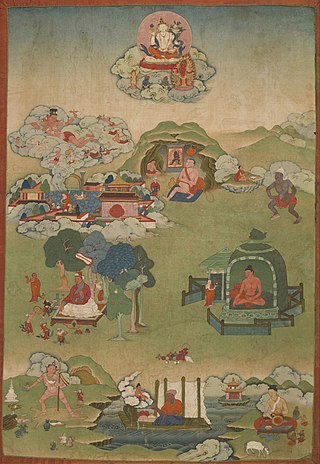
Tibetan tantric practice, also known as "the practice of secret mantra", and "tantric techniques", refers to the main tantric practices in Tibetan Buddhism. The great Rime scholar Jamgön Kongtrül refers to this as "the Process of Meditation in the Indestructible Way of Secret Mantra" and also as "the way of mantra," "way of method" and "the secret way" in his Treasury of Knowledge. These Vajrayāna Buddhist practices are mainly drawn from the Buddhist tantras and are generally not found in "common" Mahayana. These practices are seen by Tibetan Buddhists as the fastest and most powerful path to Buddhahood.
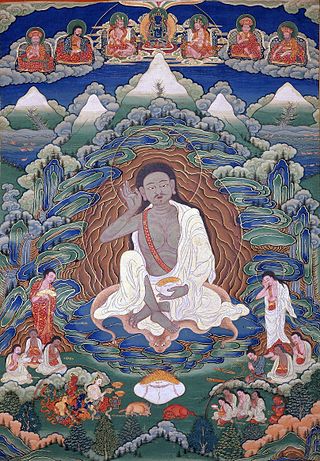
In Tibetan Buddhism and Bon, a ngagpa (male), or a ngagmo (female) is an ordained non-monastic practitioner of Dzogchen and Tantra. Traditionally, many Nyingma ngakpas wear uncut hair and white robes and these are sometimes called "the white-robed and uncut-hair group".
The Sarvatathāgatatattvasaṃgraha sutra, also known as the Tattvasaṃgraha Tantra, is an important seventh century Indian Buddhist tantric text. Although the scripture refers itself as a Mahayana sutra, the content is mainly tantric in nature and thus is sometimes called a tantra. This work is an important source for the Shingon tradition.

Theos Casimir Hamati Bernard (1908–1947) was an American explorer and author known for his work on yoga and religious studies. He was the nephew of Pierre Arnold Bernard, "Oom the Omnipotent", and like him became a yoga celebrity.
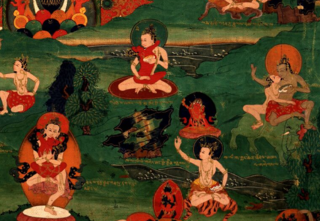
Karmamudrā is a Vajrayana Buddhist technique which makes use of sexual union with a physical or visualized consort as well as the practice of inner heat (tummo) to achieve a non-dual state of bliss and insight into emptiness. In Tibetan Buddhism, proficiency in inner heat yoga is generally seen as a prerequisite to the practice of karmamudrā.
Jacob P. Dalton is an American professor of religion and Tibetan studies at the University of California at Berkeley, where he is the first holder of a chair endowed by the Khyentse foundation. He had previously worked as a professor at Yale University and a researcher at the British Library.
Janet Gyatso is a Religious Studies scholar currently employed as the Hershey Professor of Buddhist Studies and the Associate Dean for Faculty and Academic Affairs at Harvard Divinity School. She is a member of the American Academy of Arts and Sciences. Gyatso's research interests are in Buddhism and its relationship to Tibetan and South Asian civilizations.
Georgios T. Halkias is a Greek scholar of Oriental Studies with publications on Tibetan Buddhism, Himalayan regions, and cross-cultural contacts between Hellenism and Buddhism. He is currently an associate professor of Buddhist Studies at the University of Hong Kong. and co-editor in chief of the Oxford Encyclopedia of Buddhism
